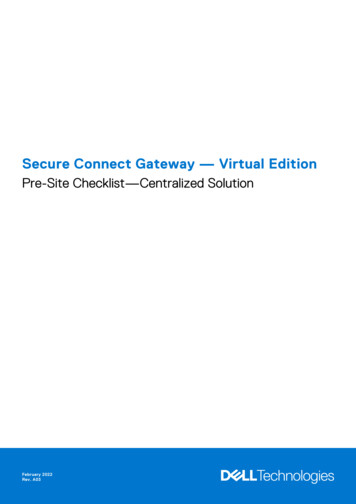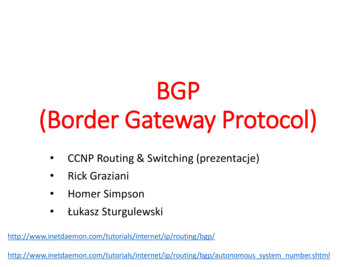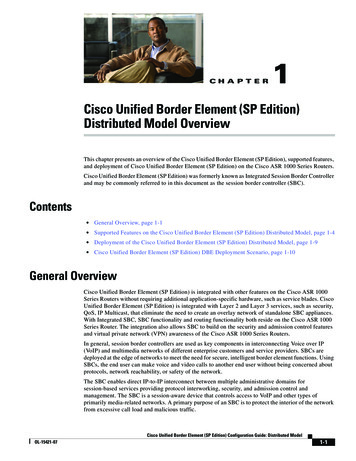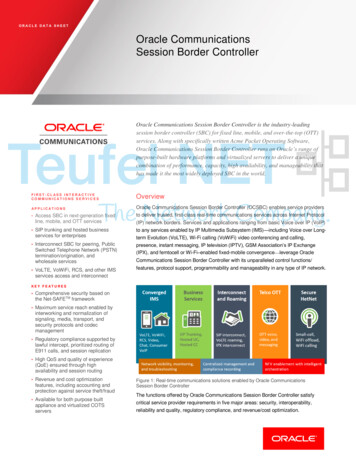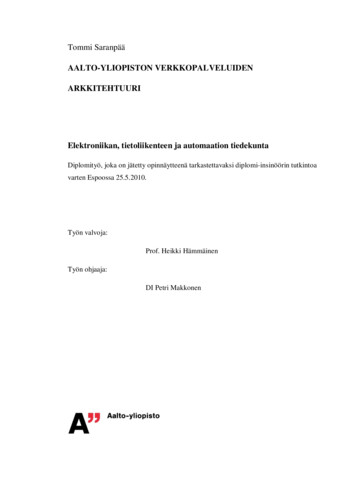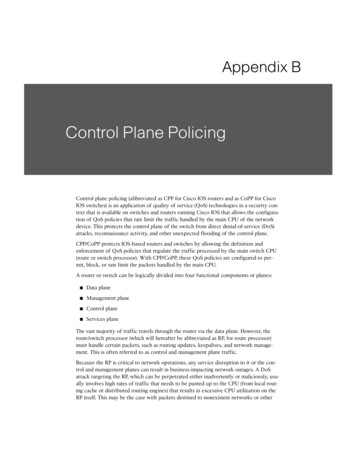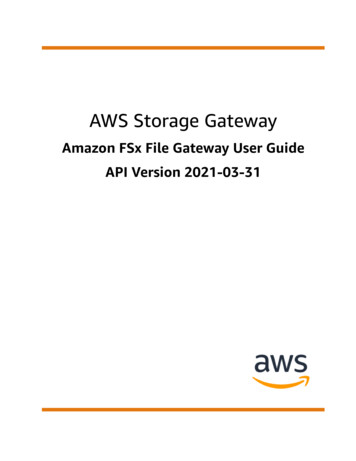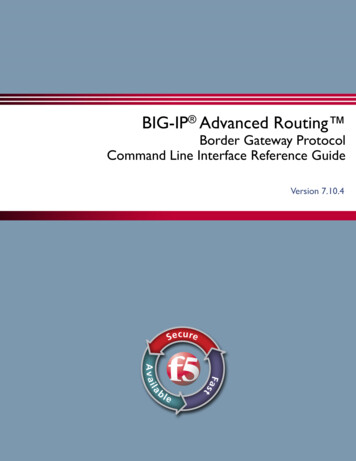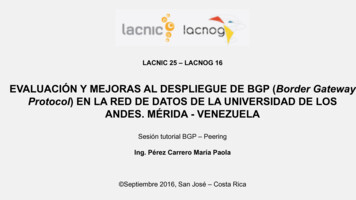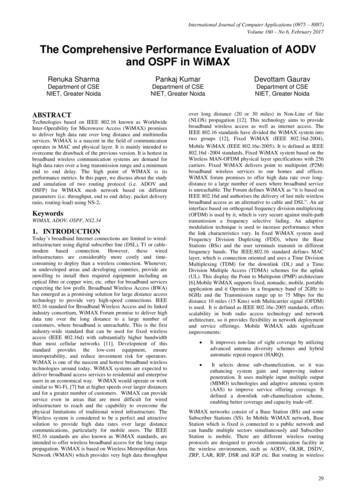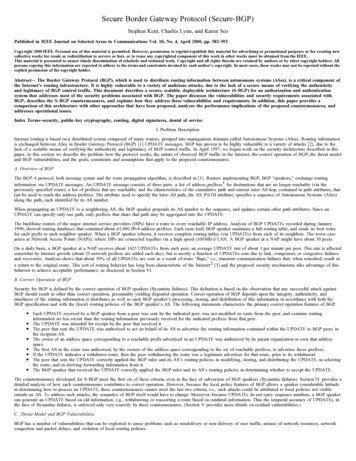
Transcription
Secure Border Gateway Protocol (Secure-BGP)Stephen Kent, Charles Lynn, and Karen SeoPublished in IEEE Journal on Selected Areas in Communications Vol. 18, No. 4, April 2000, pp. 582-592Copyright 2000 IEEE. Personal use of this material is permitted. However, permission to reprint/republish this material for advertising or promotional purposes or for creating newcollective works for resale or redistribution to servers or lists, or to reuse any copyrighted component of this work in other works must be obtained from the IEEE.This material is presented to ensure timely dissemination of scholarly and technical work. Copyright and all rights therein are retained by authors or by other copyright holders. Allpersons copying this information are expected to adhere to the terms and constraints invoked by each author’s copyright. In most cases, these works may not be reposted without theexplicit permission of the copyright holder.Abstract-- The Border Gateway Protocol (BGP), which is used to distribute routing information between autonomous systems (ASes), is a critical component ofthe Internet’s routing infrastructure. It is highly vulnerable to a variety of malicious attacks, due to the lack of a secure means of verifying the authenticityand legitimacy of BGP control traffic. This document describes a secure, scalable, deployable architecture (S-BGP) for an authorization and authenticationsystem that addresses most of the security problems associated with BGP. The paper discusses the vulnerabilities and security requirements associated withBGP, describes the S-BGP countermeasures, and explains how they address these vulnerabilities and requirements. In addition, this paper provides acomparison of this architecture with other approaches that have been proposed, analyzes the performance implications of the proposed countermeasures, andaddresses operational issues.Index Terms–security, public-key cryptography, routing, digital signatures, denial of serviceI. Problem DescriptionInternet routing is based on a distributed system composed of many routers, grouped into management domains called Autonomous Systems (ASes). Routing informationis exchanged between ASes in Border Gateway Protocol (BGP) [1] UPDATE messages. BGP has proven to be highly vulnerable to a variety of attacks [2], due to thelack of a scalable means of verifying the authenticity and legitimacy of BGP control traffic. In April 1997, we began work on the security architecture described in thispaper. In this section we describe the problem–how the protocol works, the nature of observed BGP traffic in the Internet, the correct operation of BGP, the threat modeland BGP vulnerabilities, and the goals, constraints and assumptions that apply to the proposed countermeasures.A. Overview of BGPThe BGP-4 protocol, both message syntax and the route propagation algorithm, is described in [1]. Routers implementing BGP, BGP "speakers," exchange routinginformation via UPDATE messages. An UPDATE message consists of three parts: a list of address prefixes 1 for destinations that are no longer reachable (via thepreviously specified route); a list of prefixes that are reachable; and the characteristics of the cumulative path and current inter-AS hop, contained in path attributes, thatcan be used to reach the address prefixes. The attribute used to specify the inter-AS path, the AS PATH attribute, specifies a sequence of Autonomous Systems (ASes)along the path, each identified by its AS number.When propagating an UPDATE to a neighboring AS, the BGP speaker prepends its AS number to the sequence, and updates certain other path attributes. Since anUPDATE can specify only one path, only prefixes that share that path may be aggregated into the UPDATE.The backbone routers of the major internet service providers (ISPs) have a route to every reachable IP address. Analysis of BGP UPDATEs recorded during January1999, showed routing databases that contained about 61,000 IPv4 address prefixes. Each (non-leaf) BGP speaker maintains a full routing table, and sends its best routefor each prefix to each neighbor speaker. When a BGP speaker reboots, it receives complete routing tables (via UPDATEs) from each of its neighbors. The worst casearises at Network Access Points (NAPs), where ISPs are connected together via a high speed (100Mb/s) LAN. A BGP speaker at a NAP might have about 30 peers.On a daily basis, a BGP speaker at a NAP receives about 1425 UPDATEs from each peer, an average UPDATE rate of about 1 per minute per peer. This rate is affectedsomewhat by Internet growth (about 25 network prefixes are added each day), but is mostly a function of UPDATEs sent due to link, component, or congestive failuresand recoveries. Analysis shows that about 50% of all UPDATEs are sent as a result of route "flaps," i.e., transient communication failures that, when remedied, result ina return to the original route. This sort of routing behavior has long been characteristic of the Internet 2 [3] and the proposed security mechanisms take advantage of thisbehavior to achieve acceptable performance, as discussed in Section VI.B. Correct Operation of BGPSecurity for BGP is defined by the correct operation of BGP speakers (Byzantine failures). This definition is based on the observation that any successful attack againstBGP should result in other than correct operation, presumably yielding degraded operation. Correct operation of BGP depends upon the integrity, authenticity, andtimeliness of the routing information it distributes as well as each BGP speaker’s processing, storing, and distribution of this information in accordance with both theBGP specification and with the (local) routing policies of the BGP speaker’s AS. The following statements characterize the primary correct operation features of BGP.Each UPDATE received by a BGP speaker from a peer was sent by the indicated peer, was not modified en route from the peer, and contains routinginformation no less recent than the routing information previously received for the indicated prefixes from that peer.The UPDATE was intended for receipt by the peer that received it.The peer that sent the UPDATE was authorized to act on behalf of its AS to advertise the routing information contained within the UPDATE to BGP peers inthe recipient AS.The owner of an address space corresponding to a reachable prefix advertised in an UPDATE was authorized by its parent organization to own that addressspace.The first AS in the route was authorized, by the owners of the address space corresponding to the set of reachable prefixes, to advertise those prefixes.If the UPDATE indicates a withdrawn route, then the peer withdrawing the route was a legitimate advertiser for that route, prior to its withdrawal.The peer that sent the UPDATE correctly applied the BGP rules and its AS’s routing policies in modifying, storing, and distributing the UPDATE, in selectingthe route, and in deriving forwarding information from it.The BGP speaker that received the UPDATE correctly applied the BGP rules and its AS’s routing policies in determining whether to accept the UPDATE.The countermeasures developed for S-BGP meet the first six of these criteria, even in the face of subversion of BGP speakers (Byzantine failures). Section IV provides adetailed analysis of how each countermeasure contributes to correct operation. However, because the local policy features of BGP allows a speaker considerable latitudein determining how to process an UPDATE, these countermeasures cannot meet the last two criteria, i.e., such attacks could be attributed to local policies not visibleoutside an AS. To address such attacks, the semantics of BGP itself would have to change. Moreover, because UPDATEs do not carry sequence numbers, a BGP speakercan generate an UPDATE based on old information, e.g., withdrawing or reasserting a route based on outdated information. Thus the temporal accuracy of UPDATEs, inthe face of Byzantine failures, is enforced only very coarsely by these countermeasures. (Section V provides more details on residual vulnerabilities.)C. Threat Model and BGP VulnerabilitiesBGP has a number of vulnerabilities that can be exploited to cause problems such as misdelivery or non-delivery of user traffic, misuse of network resources, networkcongestion and packet delays, and violation of local routing policies.
Communication between BGP peers is subject to active and passive wiretapping. BGP uses TCP/IP for transport and this protocol, and its payload, can be attacked. Aspeaker’s BGP-related software, configuration information, or routing databases may be modified or replaced illicitly via unauthorized access to a router, or to a serverfrom which router software is downloaded, or via a spoofed distribution channel. Most of these attacks transform routers into hostile insiders. Effective security measuresmust address such Byzantine attacks.Exploitation of these vulnerabilities allows a variety of attacks. For example, fictitious BGP messages might be injected into a link (spoofing). Authentic BGP messagesmight be captured and either modified and re-injected into the link, combined incorrectly, or suppressed altogether. A compromised BGP speaker could generateUPDATEs for routes that do not, legitimately, pass through that speaker. All of these attacks are countered by the mechanisms described in Section III.UPDATE messages could be generated too frequently by a compromised BGP speaker, or the selection of routes and distribution of UPDATEs could violate the localrouting policies. These failures are not addressed by the proposed countermeasures.Better physical and procedural security for network management facilities, BGP speakers, and communication links; link-level encryption of inter-router (BGP speaker)traffic; and end-to-end encryption of management information would reduce some of these vulnerabilities. However, some aspects of such security approaches areeconomically unattractive or infeasible. Moreover, accidental (vs. malicious) misconfiguration would not be prevented by such measures and such misconfiguration hasproved to be a source of several significant Internet outages in the past. Any security approach that leaves BGP vulnerable to such benign "attacks" violates the"principle of least privilege" and leaves the Internet routing system vulnerable at its weakest link. In contrast, the security approach described here satisfies thisprinciple, so that any attack on any component of the routing system is limited in its impact on the Internet as a whole.D. Goals, Constraints, and AssumptionsIn order to create countermeasures that are both effective and practical, the S-BGP architecture is based on the following goals, constraints, and assumptions.The S-BGP architecture must handle the projected growth and usage of the Internet in terms of performance (storage, processing, network bandwidth). It should bedynamic (responding automatically to topology changes, including the addition of new networks, routers and ASes) and scalable (able to handle the growth of theInternet in terms of addresses, routes, BGP control traffic, etc.).The countermeasures must be consistent with the BGP protocol standards and with the likely evolution of these standards. This includes packet size limits, e.g., 4096byte maximum for UPDATEs, and BGP features, e.g., path aggregation, communities, and multi-protocol support, e.g., multi-protocol label switching (MPLS). Forexample, to avoid modifying BGP packet formats, we have chosen to employ the BGP optional, transitive path attribute as a mechanism for distributing countermeasuresinformation. Non S-BGP routers should pass this attribute type transparently, without understanding it.The S-BGP architecture must be deployable. A primary goal of this work is to not only find countermeasures for BGP vulnerabilities but to cause them to be adopted byISPs and router vendors. To accomplish this, the countermeasures must use available technology that can be incrementally deployed and they should leverage off of theexisting infrastructure, e.g., the Internet Corporation for Assigned Names and Numbers (ICANN), and routing registries. In addition, they must avoid dependency loops,i.e., the architecture cannot depend on correct operation of inter-AS routing during initialization, e.g., it cannot rely on non-local databases.II. Prior WorkThe earliest significant work published on the topic of routing protocol security is Perlman’s doctoral dissertation [21]. The S-BGP design shares several features of thatwork, e.g., we address Byzantine failures and make extensive use of digital signatures. However we differ in many other respects, e.g., our design applies to a standardexterior (vs. interior) routing protocol, and we pay considerable attention to infrastructure and performance implications.At the time that we began this work, previously published work on improving the security of BGP, and more generally distance-vector protocols, included proposals foradding sequence numbers to BGP messages [4,5,6], authentication of BGP messages [1,5,6], neighbor-to-neighbor encryption of BGP messages [4], and addinginformation to UPDATE messages to protect against tampering as the UPDATE propagates around the Internet [4,5,7].None of this work proposed a comprehensive solution to the BGP security problems described above; each focused on one or more aspects of the problem withoutconsidering the full range of issues that are critical to a viable solution. For example, none addressed issues associated with the generation and distribution of public keycertificates and certificate revocation lists (CRLs) needed to support validation of signed UPDATEs. Some proposals made changes to BGP that are inconsistent with theprotocol standards, a reasonable approach only if one were presented with a "clean slate." None of the prior work examined the statistics of BGP operating in theInternet; this sometimes led authors to focus on performance concerns that are not the major impediment to deploying viable solutions. Some of the work developedsolutions for distance vector protocols, but erroneously claimed applicability to BGP, which is described as a path vector protocol.In contrast, the BGP security architecture reported in this paper is comprehensive, including a design for the infrastructure needed to establish and maintain the system.The optional transitive path attribute it employs is consistent with BGP standards and can be safely carried through routers not implementing S-BGP. This architectureincorporates the notion of an address attestation, which establishes that a "first hop" BGP speaker is authorized to advertise a route to a destination. No prior workincludes an equivalent notion. Finally, the performance of the design presented here has been modeled based on actual BGP statistics. No other work has been sorigorously analyzed from a performance perspective.In [7], the scheme proposed is similar to our route attestations (RAs) in that before distributing an UPDATE to an external neighbor, the BGP speaker signs the route.Our approach differs from the scheme proposed in [7] in that we sign a routing data structure that specifies the next hop AS, explicitly indicating that this AS isauthorized to advertise the route in question to the identified neighbor. Hence, our approach avoids a vulnerability not addressed in [7], i.e., provides protection against"cut and paste attacks" in which a BGP speaker inserts itself into a route (using a valid UPDATE containing a route which the speaker was not authorized to use).The approach proposed in [4,5] was developed in response to the perceived communication and computation overhead of schemes such as [7]. In the case of [7] (and ourroute attestations), each of the signatures must be carried in each UPDATE and verified by each recipient to validate each received UPDATE. The approach proposed in[4,5] includes only a single signature for a route in an UPDATE; this signature covers only the destination and penultimate ASes listed in the path and is generated by aBGP speaker in the destination AS. While the overhead of [4,5] is less than that of [7] or our route attestations, it fails to provide the protection afforded by the iteratedsignature schemes in an environment with more sophisticated routing policies (e.g., policies other than shortest path), such as those typically supported by BGP.Moreover, our analysis shows that generation, validation, and transmission of digital signatures does not impose an unacceptable computational or communicationburden.III. Proposed CountermeasuresThe approach adopted to securing BGP route distribution involves two Public Key Infrastructures 3 (PKIs), a new path attribute containing "attestations", and the use ofIPsec. These components are used by a BGP speaker to validate the authenticity and data integrity of BGP UPDATEs that it receives and to verify the identity andauthorization of the senders. This section discusses in more detail the PKIs and certificates, the attestations, the use of IPsec, and the distribution of thiscountermeasures information.A. Public Key Infrastructures (PKIs) and CertificatesS-BGP uses two PKIs, based on X.509 (v3) certificates, to enable BGP speakers to validate the identities and authorization of BGP speakers and of owners of ASes andof portions of the IP address space. These PKIs parallel the existing IP address and AS number assignment delegation system and take advantage of this extantinfrastructure. Because these PKIs mirror existing infrastructure, their creation avoids many of the "trust" issues that often complicate the creation of a PKI. The twoPKIs involve four types of certificates, as illustrated below. In the diagrams:
The higher node is the issuer for the certificates defined in the tier below it.The name of the current tree node (organization, AS, router, etc.) is the subject of the certificate.Any additional fields shown in the node, e.g., address block(s), are in an extension in the certificate.Other X.509 certificate fields are assumed, but not shown–sequence number, subject public key, signature, validity period, etc.Note that the organizations that assign addresses (Registries, ISPs, DSPs, etc.) and the organizations that obtain autonomous system numbers from a Registry may bedifferent. An organization could receive its AS number from a registry and its address block from an ISP. So the Org3 4 shown in the first PKI hierarchy (Figure 1)could correspond to the Org 1 shown in the second PKI hierarchy (Figure 2).Figure 1: Address Allocation PKI Structure1) A PKI for Address Allocation: This architecture calls for a certificate to be issued to each organization that is granted "ownership" of a portion of the IP addressspace. This certificate is issued through the same chain of entities that, in the existing environment, is responsible for address allocation. The root of this chain is theICANN, followed by regional address space allocation authorities (e.g., ARIN and RIPE), ISPs, DSPs, and end users. Note that the proposed system does not require thataddress assignments be certified all the way to the subscriber. If a subscriber’s address is allocated from that of a DSP or an ISP with which it is currently affiliated,then the certification process need only be effected as far as the ISP/DSP. The same applies to DSPs that receive their address-space assignments from ISPs. Also notethat a subscriber (or a DSP) who does not participate in BGP exchanges (e.g., is singly-homed) need not be issued a certificate if the subscriber’s address space isderived from that of an encompassing ISP or DSP.4 Finally, if an organization owns multiple ranges of addresses, this design calls for assigning a single certificate5containing a list of address blocks, so as to minimize the number of certificates needed to validate an UPDATE.This PKI reflects the assignment of address blocks to organizations by binding address block(s) to a public key belonging to the organization to which the addresses arebeing assigned. Unlike a typical X.509 certificate, the identity of the subject is not the primary focus of these certificates; instead, these certificates are used to proveownership of a block of addresses.6 Each certificate in this PKI contains a (private) extension that specifies the set of address blocks that have been allocated to theorganization. The subject alternate name in each certificate is the DNS name of an organization: an ISP, DSP, or a subscriber. The ICANN, as root, is representednominally by a self-signed certificate that contains an extension expressing ownership of the entire address space.In Figure 1 we note the following.a . ICANN is the root and issues certificates to the first tier of organizations (Org1 x). Under current practice, Org1 x would be an Internet Registry, althoughhistorically it could have been an ISP, an organization, etc. ICANN signs the tier 1 certificates using its private key.b. Org1 x then assigns sub-blocks of its address space to ISPs or DSPs. In the diagram, for example, Org1 1 issues a certificate to each of Org2 1 throughOrg2 7 and Org1 N issues a certificate to Org2 8. Org1 x signs the certificate using the private key corresponding to the public key in the certificate itreceived in (a).c . Org2 x then assigns sub-blocks of its address space to customers, DSPs, etc. In the diagram, Org2 1 issues a certificate to each of Org3 1 through Org3 4.Org2 x signs the certificate using the private key corresponding to the public key in the certificate it received in (b).d. And so on .Table 1 summarizes the Issuer/Subject relationships for the certificates in this PKI.Certificate ryISP/DSPRegistry (or ICANN or ISP)ISP/DSPSubscriberISP/DSP (or Registry or ICANN)SubscriberTable 1: Address Allocation PKI Certificate Overview
Figure 2: Autonomous System Identification and BGP Speaker PKI2) A PKI for Assignment of ASes and Router Associations: Three types of certificates will be used to support the authentication of ASes and BGP speakers, and therelationship between speakers and ASes. Here too the ICANN is the root and the next tier consists of registries, but the third tier consists of organizations that ownASes, followed by a tier of AS numbers and routers. The result is a broader, shallower certification tree. As before, this tree parallels existing "trust relationships," i.e.,the ICANN assigns AS numbers to registries, which in turn assign one or more AS numbers to organizations (e.g., ISPs/DSPs) that run BGP. Each of these organizationsis authoritative for identifying routers as representatives (BGP speakers) for the AS(es) that the organization owns. In order to express the ownership of an AS by anorganization, each third tier certificate carries an extension that enumerates the ASes assigned to that organization. Validation of fourth tier certificates requires matchingasserted AS numbers against these extensions. For each fourth tier AS certificate (b, below) there are typically several router (BGP speaker) certificates (c, below), eachspecifying the same AS number. (Note that there could be more than one certificate assigned to a BGP speaker if the speaker acts as a proxy for another AS.) As shownin the Figure 2, these 3 types of certificates bind together:a . AS numbers and an organization’s public key–a registry issues these to organizations and signs them using its private key. The alternate name in the certificateis the DNS name of the organization. An extension contains the (list of ranges of) AS number(s).b. An AS number and its public key–An organization issues these and signs them using the private key corresponding to the public key in the certificate describedin (a). The issuer alternate name in the certificate is the DNS name of the organization. The subject alternate name is the AS number.c . A router (DNS) name, a router id, an AS number, and the router’s public key–An organization issues these and signs them using the private key correspondingto the public key in the certificate described in (a). Both the router id (an IP address) and the AS number are extensions in this certificate, and the binding ofthree items is a critical aspect of this certificate. The alternate name in the certificate is the DNS name of the router corresponding to the router id.Certificate TypeIssuerSubjectExtensionsRootICANNICANNAll AS #sRegistryICANNRegistryAS #sAS OwnerRegistry (or ICANN)ISP/DSP or SubscriberAS #sASISP/DSP or SubscriberAS number (in DNS format)AS #BGP SpeakerISP/DSP or SubscriberBGP Speaker DNS nameAS #, Router IDTable 2: AS and BGP Speaker PKI Certificate OverviewB. AttestationsAn attestation establishes that the subject of the attestation (an AS) is authorized by the issuer to advertise a path to the specified blocks of address space. There are twoclasses of attestations, address and route, although a single format is employed to represent both. Route attestations are carried in a new type of optional BGP pathattribute as part of UPDATE messages:Address attestations. Here the issuer is the organization that owns the address space and the subject is an AS that may originate it, e.g., the organization’sprovider. The issuer signs an address attestation using the private key that corresponds to the public key in the certificate (see Figure 1) assigning this addressspace to the issuer.Route attestations. Here the subject is a transit AS. A route attestation is signed by the S-BGP speaker (or offline by the management of the AS). The signeruses the private key that corresponds to the public key in the certificate that binds the speaker to the subject AS (see Figure 2).
If an organization has more than one AS, there are separate attestations for each AS rather than just one attestation containing multiple AS numbers. Each AS will haveits own set of BGP speakers and its own authentication certificate(s) as well. This applies to both the stub and transit AS cases. Figure 3 summarizes the structure foraddress and route attestations.Figure 3: UPDATE Format with Route AttestationsC. Route ValidationAttestations and certificates are used by BGP speakers to validate routes asserted in UPDATE messages, i.e., to verify that the first AS in the route has been authorizedto advertise the address block(s) by the address block owner(s), and that each subsequent AS has been authorized to advertise the route for the address block(s) by thepreceding AS in the route. To validate a route received from AS n , ASn 1 needs:1 address attestation from each organization owning an address block or blocks in the NLRI1 address allocation certificate from each organization owning an address block or blocks in the NLRI1 route attestation from every S-BGP speaker (or its AS) along the path (AS n to AS1 ), where the route attestation generated and signed by router x (or ASx )specifies the NLRI and the AS PATH from AS x 1 through AS 11 certificate for each S-BGP speaker along the path (AS n to AS 1 ) to check the signatures on the route attestationsand, of course, all the relevant CRLs must have been verified.This means that for each UPDATE, there must be attestations confirming that all the ASes in the BGP UPDATE are authorized to advertise routes to the destination IPaddress block(s). This includes ASes that are providing third party advertisements for ASes that are not running BGP.The attestations are not used for checking withdrawn routes because the authorization of the BGP speaker to advertise those routes was verified at the time they wereinstalled into the local routing information base (Loc-RIB). Moreover, if the BGP speaker has lost the authorization to advertise that route, then the route is by definitionno longer valid and should be withdrawn.Use of IPsec on inter-router communication paths prevents an active wiretapper from spoofing route withdrawals, or replaying valid UPDATEs at times when a BGPspeaker would not transmit them, e.g., after a route has been withdrawn and prior to advertisement of the same or a different route.D. Distribution of Countermeasures InformationThis section discusses the mechanisms used to distribute certificates, CRLs, and address and route attestations to the relevant devices performing route validation: S-BGPspeakers, route servers, etc.1) Distribution of Certificates, CRLs and Address Attestations: Each S-BGP speaker must have access to the public keys required to validate UPDATEs. For non-leafS-BGP speakers, this amounts to a full set of certificates encompassing all address space owners, AS owners, and some number of S-BGP speakers (plus the ICANNand registry certificates). An X.509 certificate used in this environment is about 450 bytes long, depending on naming conventions and extensions. In the current (June1999) Internet environment, there are approximately 5,300 autonomous systems, 44,000 organizations that own address prefixes, and 7,500 BGP speakers. The resultingcertificate database comprises about 32 Mbytes, and it can be expected to grow each year as more address prefixes, autonomous systems, and BGP speakers are added.The CRL database associated with these certificates would add to this total, though probably not significantly, since these certificates are issued to organizations anddevices, not peopleAt first glance it might seem appropriate to transmit certificates as part of each UPDATE. This would ensure that each receiving BGP speaker would receive all the dataneeded to validate the route attestations in an UPDATE, and it would be easy for each BGP speaker to include its own certificate as part of the forwarding process.However, this would be very wasteful of bandwidth, as each BGP speaker would receive many redundant copies of certificates. 7 More importantly, this approach isinfeasible, because BGP UPDATEs are limited in length to 4096 bytes and thus are too small to carry the necessary cer
Communication between BGP peers is subject to active and passive wiretapping. BGP uses TCP/IP for transport and this protocol, and its payload, can be attacked. A speaker's BGP-related software, configuration information, or routing databases may be modified or replaced illicitly via unauthorized access to a router, or to a server
